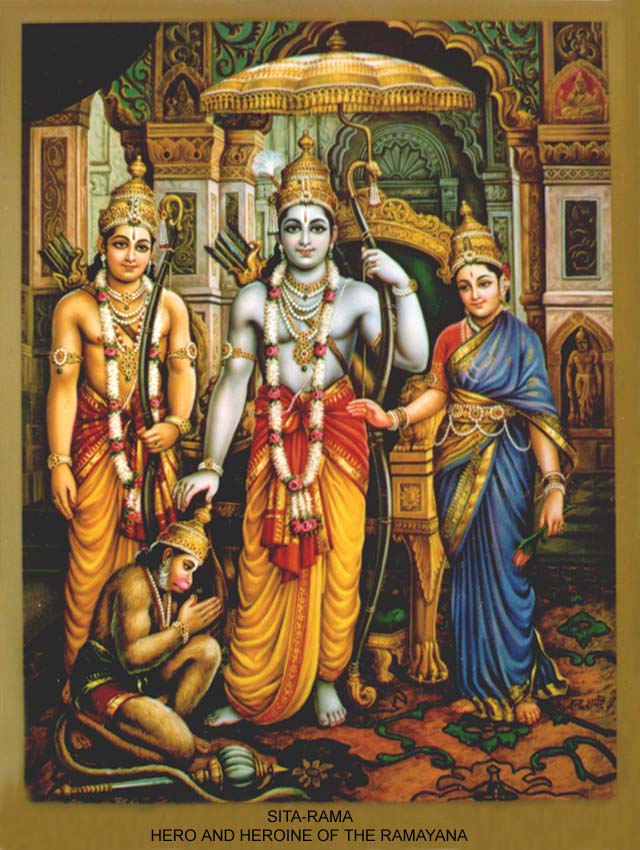In this posting I am presenting the two verses numbers 11 and 12 as they both talk about the word Rama. Before we enjoy Civavakkiyar's thoughts on the name Rama let us see a little about the symbolism of Rama. The picture I have presented above is known to many of us. It depicts Rama, his wife Sita, his brother Lakshmana and his helper/devotee, Hanuman. Rama signifies the Supreme Godhead or Siva. Sita represents Sakti. Lakshmana represents the limited soul and Hanuman, the guru. Rama's bow signifies the sushumna nadi, his arrows, the ten types of breaths that, when directed through the sushumna nadi, confer Universal consciousness.
In some other explanations Sita is considered the limited soul. The guru, Hanuman, brings together the limited soul, Sita, who is separated from the Universal soul, Rama. A guru conveys the knowledge about the Divine to the limited soul (Hanuman brought Rama's ring to Sita) and presence of the limited soul to the Divine soul (he brought Sita's head ornament to Rama).
The triad, Rama, Sita and Lakshmana are said to represent the letters, a, u and m of the pranava, aum. The depiction of Sita walking between Rama and Lakshmana is said to represent the Supreme consciouness a, the inactive state, prakasha, being followed by the Sakti, u, the active aspect which in turn is followed by m or maya, the supreme creative power of the Divine, the cause for the manifested world.
Verse
11
கதாவுபஞ்ச பாதகங்க ளைத்துறந்த மந்திரம்
இதாம் இதாம் அதல்லஎன்று வைத்துழலும் ஏழைகள்
சதாவிடாமல் ஓதுவார் தமக்குநல்ல மந்திரம்
இதாம் இதாம ராமராம ராமஎன்னும் நாமமே!
Translation:
Ignorant
people who roam around saying
The
mantra that can remove the five fearsome sins is this, is this and not that!
The
potent mantra for those who chant it always and continuously
Is
this, is this, Rama, Rama, the name, Rama.
Commentary:
Civavākkiyar continues to explain the
greatness of the name, Rama, in this verse. He says that ignorant people are in
search of a mantra to remove their sins but the only mantra that can do it is
the name Rama. Panca pātakam
refers to the five dreadful sins- murder, rape, insulting one’s preceptor,
lying and thieving. Chanting the name, Rama, will annul even these deplorable
sins.
Verse
12
நானதேது? நீயதேது? நடுவில் நின்றது ஏதடா?
கோனதேது? குருவதேது? கூறிடும் குலாமரே!
ஆனதேது? அழிவதேது? அப்புறத்தில் அப்புறம்
ஈனதேது? ராமராம ராமஎன்ற நாமமே!
Translation:
Who
am I? Who are you? Hey! What is that
which stood between?
Who
is the king? Who is the preceptor? Please tell, you slaves!
What
is created? What is destroyed? Beyond the beyond
What
gave birth to all these? Rāma, Rāma, the
name that is verily Rāma!
Commentary:
In this verse, Civavākkiyar
elaborates that everything is Rama. The
limited soul is Rama, the universal soul is Rama, the relationship that stands
between them is also Rama; the king, the guru, the created, the destroyed, that
which is beyond the beyond-everything is Rama.
The name of the Ultimate Reality, Rama, is the cause for all these.
In this connection, we may make one
observation. In Tamil Siddha poetry, we
find several mystical syllables, a large number of short un-etymological vocables,
such as krim, hrim, hum etc. Rama is one such mystical term. For the uninitiated, these letters remain
unintelligible because their meaning does not belong to the rational language,
which serves to communicate ordinary experiences. These mystical syllables are abbreviations of
the psychic energies or mystical consciousness located in each cakra. These sounds reveal their messages during
meditation. To an aspirant or a sādhaka,
these syllables including the term “Rama” therefore have a value of secret
initiatory language. Hence, we can
safely say that the monosyllables that we find in Siddha poetry are no longer
gibberish. They have a meaning and a
message.

No comments:
Post a Comment